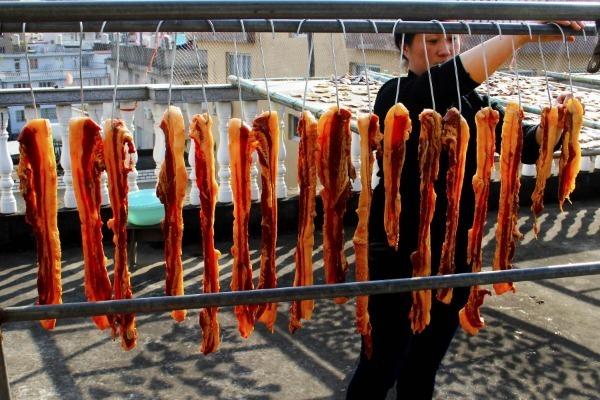 A woman in Wenzhou, Zhejiang province, hangs up cured meat to dry in the last month of the lunar calendar. (CAI KUANYUAN / FOR CHINA DAILY)
A woman in Wenzhou, Zhejiang province, hangs up cured meat to dry in the last month of the lunar calendar. (CAI KUANYUAN / FOR CHINA DAILY)
The last month of the lunar calendar used to be called the Hunting Month, or La Yue, in more rustic times. That was when traps were set in the wild to catch pheasants, rabbits, deer and wild boar in preparation for the rounds of feasting during Spring Festival, just a week away from now.
That was when traps were set in the wild to catch pheasants, rabbits, deer and wild boar in preparation for the rounds of feasting during Spring Festival, just a week away from now
In spite of the urban spread of China's population, the year-end tradition of preserving meat is still very popular, where a variety of birds, cuts of beef, mutton, pork and fish can be seen strung up in backyards and balconies alike to catch the winter north wind and sun.
Sausages are made from hand-cut pork belly and marinated in salt, sugar and yellow rice wine, which has a characteristic red tinge.
This is also the time when fresh duck or goose livers are marinated in spices, sugar and wine and stuffed into intestines. Unlike the meat sausages, these seasonal delicacies are only available for a limited time.
One regional specialty is whole pig liver, hollowed out and stuffed with a piece of pork fat. Surprisingly, they are not hard to eat. The liver turns firm during the curing process, while the fat turns crisp and transparent. The Cantonese cook steams, then cuts these liver sausages into very thin slivers, serving them on slices of steamed arrowhead or yam.
More familiar are whole ducks which are spatchcocked, spiced and salted. The intensely savory birds will be a highlight on reunion tables on Lunar New Year's Eve. Surprisingly, chickens are cooked fresh and seldom cured in the southern regions.
Further north, in Yunnan and Sichuan, various cuts of meat are heavily seasoned and hung up to dry, ending up in stir-fries, or simply steamed. Here, the meats are pickled with lots of chilli and Sichuan peppercorns.
In Ningbo, Zhejiang province, a favorite new year delicacy is a type of ham, featuring chopped pork stuffed into a pig's stomach and then cured in brine.
In Hubei, where there are plenty of lakes and ponds, preparations for spring start with fishing for carp. Whole carp are salted and then hung up to dehydrate but a good cured carp stays soft and supple for the Lunar New Year meals.
The Hunting Month may have slowly evolved into the curing month, yet it is still part of a culinary tradition that is a prelude to the most important celebration of the entire lunar year-Spring Festival.
ALSO READ: Spring Festival to boost sales of imported goods in smaller cities
Another major indicator is on the eighth day of the last lunar month, which fell on Jan 2 this year. This is the day when every household will serve a porridge of mixed grains-laba porridge. It is the last bookmark of the previous year's harvest of cereals, pulses and brans.
The colorful mixed grains are cooked together with brown sugar and served to family and visitors. With the eating of laba porridge, the countdown to Spring Festival begins.
Recipes
Cured meat
1 kg belly pork
1 cup soy sauce
1 cup sugar
1 cup Chinese rice liquor
2 tablespoons white liquor (baijiu)
2 tablespoons salt
1 tablespoon Sichuan peppercorns
2 pods star anise
Clean the pork belly and scrape off any gristle from the skin. Dry and cut into thick strips about 3 cm wide.
Place the marinade ingredients together and mix well. Add the pork strips and allow them to soak for an hour or so. Thread or tie a length of kitchen string around one end of each strip.
Hang the meat up in a cool place where it can be air-dried. It will be ready to eat in a week to 10 days.
The same marinade can be used for spatchcocked ducks or chicken, but the drying process would be longer, according to weight.
Cured pork hock
1 small pork hock (upper part of the leg)
1 kg preserving salt (rough sea salt)
2 tablespoons Sichuan peppercorns
First, you need a covered container that will contain both the salt and pork hock.
Clean the pork, scraping off any gristle from the skin. Wash, drain and set aside.
READ MORE: Spring Festival reunion dinners a hot commodity
Using a dry pan, toast the Sichuan peppercorns till you can smell the aroma rising. Mix into the salt.
Place a layer of salt in the container to cushion the pork, then rub the rest of the salt all over the entire hock. Comb the meat with the rest of the salt.
Close the container and place in the fridge. Turn the pork hock around every few days. After three weeks or more, the cured hock will be ready.


